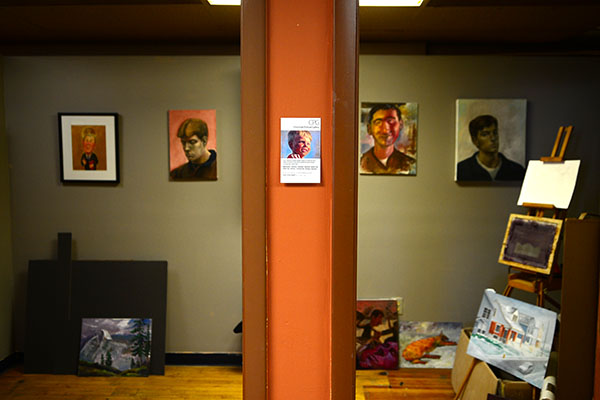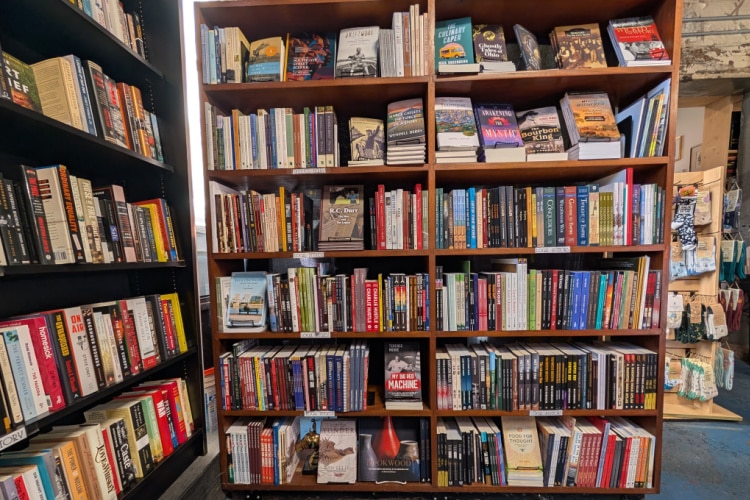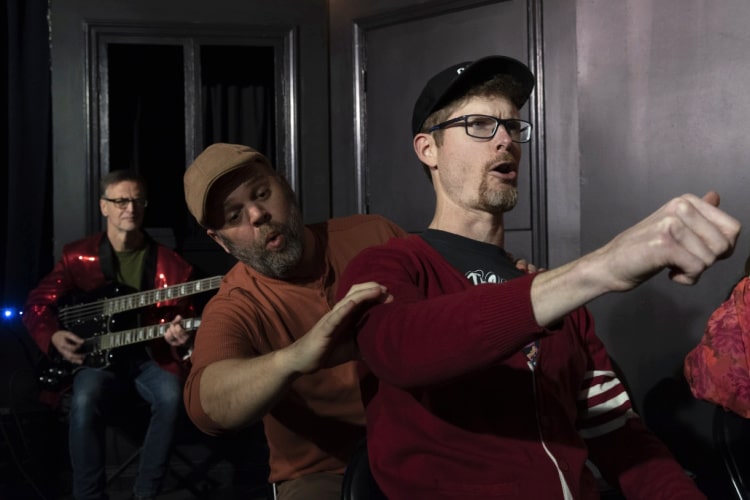Go West: Broadhope Art Collective inspires new thinking in Cheviot
Five artists share one vision in Cheviot: work together to share inspiration and build a creative community on the West Side. The result? The Broadhope Art Collective, which opened last week.
It’s a cold, dreary Friday evening in October and a light rain falls on the pavement outside 3651 Harrison Avenue in Cheviot. Vehicles rush by on the busy West Side thoroughfare, paying little attention to the activity inside the once vacant corner storefront.
Four of the core members of the Broadhope Art Collective make last-minute preparations for the next day’s soft opening. In the lull between tires accelerating on wet streets, there’s a snip of scissor blades through paper and the knock of a hammer against a wall, as well as the sound of eager voices.
While neighborhoods east of I-75 boast established, vibrant art communities with more creatives supporting and opening up shops all the time, it’s been a different story on the West Side. Aside from craft shows, there have been few attempts by artists to collectively create, display and sell their art. Broadhope artists plan to change that.
“I was joking with someone yesterday that the tagline should be, ‘Cheviot? Who Knew?’” says Abby Langdon, a 36-year-old plush artist and stay-at-home mother who represents the third generation of her family to live in their West Side home.
When she was growing up, Langdon’s parents introduced her to Cincinnati’s cultural offerings by taking her to Music Hall and the Contemporary Arts Center. They spent considerable time , and Langdon accepted the idea that enjoying and sharing the arts meant leaving the West Side.
Years later, she learned that many of her neighbors shared her artistic interests, but the community’s infrastructure kept them disconnected.
Kate Dignan, 33, is a mixed media artist and the manager of Broadhope. She grew up in Chicago, moved to Mt. Lookout 10 years ago, and has been inching her way westward ever since. She’s genuinely surprised there isn’t a precedent for their collective.
“It’s astonishing that we’re an anomaly, because there are so many crafters and artists over here,” she says. “And I think that’s why there’s been a groundswell of interest because people are like, ‘Oh, finally.’”
“Growing up here, I had a derogatory attitude toward the West Side,” Langdon adds. “I mean, it was very sweet and homey, but it wasn’t at the forefront on any trend at all.”
Dignan compares the family and culture retention of the West Side to the South Side of Chicago—roots run deep, as do traditions. Artist communities have not been part of those traditions, until now.
Despite the sluggish approach to change, both Dignan and Langdon knew after participating in local craft shows that there was substantial untapped potential.
What the West Side needed was someone to bring its artists together outside of the craft show circuit. The core group credits this feat to Jeff Baker, a Cheviot City Council member and the owner of Higher Ground Coffee, a shop located less than a block from Broadhope.
He had been trying to help Tracy Iliff and her husband Jaime find a new retail space for their custom-made pottery when Dignan—and later her boyfriend, graphic and portrait artist Gabriel Utasi—began asking him about the possibility of hanging their work in the town’s vacant storefronts.
The coffee shop soon became the meeting spot for the hopeful group. Once a core of committed artists began to coalesce, Baker let the others take control. By July, Langdon had joined the talks after receiving a heads-up email from show organizer Amanda Hogan Carlisle. The talks evolved and what emerged was a concrete concept for an artist collective that would serve as a place to sell work and conduct workshops.
The group settled on the name Broadhope as an homage to the Scottish immigrant who named Cheviot after the rolling hills in southern Scotland. Broadhope is the name of one of those hills, just like the art collective is one facet of the greater community.
Each artist had his or her own reason to support the endeavor.
For some, it was, above all, smart business. Tracie and Jamie Iliff needed a home base from which to sell their products when they travel to shows on weekends. Plus, being able to keep 100 percent of sales made at the collective allows them to pay less to share the rent of studio space there than they typically pay in hefty commissions to galleries.
“I’m tired of making it, pricing it, calling it over, letting them sell it, and then only getting 60 percent of it,” Iliff says. “And I don’t get to see my customers that way.”
Other members echoed Iliff’s desire for engagement with customers and fellow artists. “I needed more people around me for feedback,” Langdon says. “I was missing the adult interaction.”
“With an art gallery,” Iliff adds, “the artists don’t really have a stake in it. A collective is a family of artists.”
The rain had cleared by Saturday, leaving only a bright, crisp chill in the air, and when the new family of artists went to open their doors at 2 p.m., a small line of customers was already waiting. Family, friends and those who had donated to the collective’s crowdsource funding campaign filed inside, and the clientele continued to grow, eventually peaking around 80.
The work of the core group forming the LLC and that of the other gallery artists is mixed together throughout the space. Gallery artist Sharon Montavon’s colorful bead bracelets are presented on the same display as some of Langdon’s plush animals.
The Iliffs explained photographs that show how they dig clay from the Little Miami River for their pottery. The finished products set close at hand, and their glazes, made from recycled bottles, gleam in the white daylight leaking through the window.
Utasi handled sales, which for the first day consisted of nothing more than a calculator and a notepad (the cash register was the one hiccup of the opening), while patrons browsed his acrylic on paper editorial illustrations of such individuals as filmmaker Michael Moore and former president George W. Bush. The latter hangs up a ramp in his artist studio, which, along with the adjacent studios, formerly housed tanning beds when the building was a salon.
Ken Rega, 44, and Elizabeth Skipper, 34, examined a piece in a corner of the front room. They’re both from northeastern Ohio but have been in Cincinnati for 12 years and now live around the corner. They like the possibilities the store presents to the city of Cheviot and to the West Side of Cincinnati.
“When you’re over here, you don’t really think in terms of going to a neighborhood, walking around and looking at shops,” Skipper says. “To me, it’s a driving and parking lot culture, so you kind of end up driving by all these little shops. Adding something like this I think would make me walk around the neighborhood more.”
She says that if the neighborhood can attract similar offerings, it can grow into a “really cool area.”
Abby Langdon agrees. “Even though it’s kind of homespun and very traditional out here, why should we not have cool, fun, hip things, too? I think there’s an appetite for that.”
















